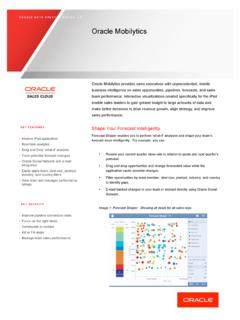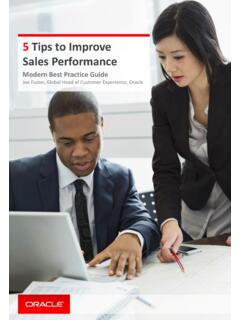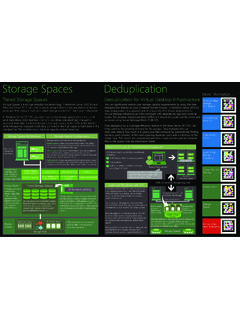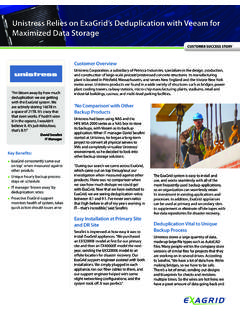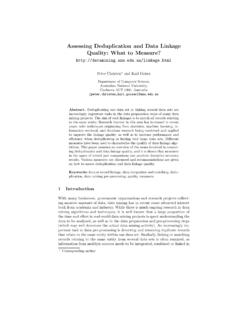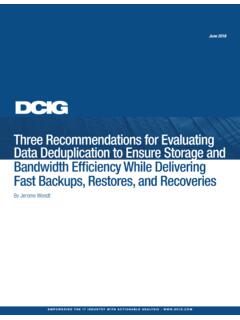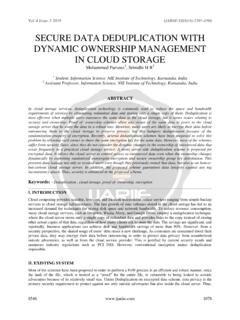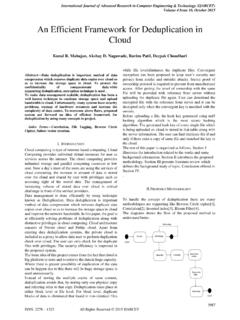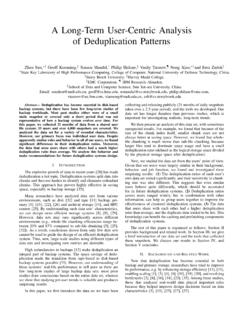Transcription of How to get the most from storage while staying within budget
1 How to get the most from storage while staying within budgeta whitepaper from Computer WeeklyIn 2011, storage represented an average of 15% of the total IT budget . Making the wrong bets on how you architect your storage environment could cause this number to grow more than your finance chief might like. In this buyer s guide, we assess the changing storage landscape and identify how the various technologies can be implemented to maximum maximum value from storage page 2 Forrester analysts Andrew Reichman and Vanessa Alvarex identify the top trends in a rapidly changing storage market and methods for implementing relevant technologies to deliver and manage business data effectively and within budgetCut costs with primary deduplication page 4 Chris Evans looks at how primary storage deduplication works, what it can achieve and how its use is set to increaseHow storage provision must change with virtual page 6desktop infrastructureCentrally run storage can suck all benefits from a VDI deployment if it is not sufficiently provisioned.
2 Writes Cliff SaranThese articles were originally published in the Computer Weekly s guideCW Buyer s guidestorage & BaCk-upthinkstockthinkstock2buyer s guideIn 2011, storage represented an average of 15% of the total IT budget . Making the wrong bets on how you architect your stor-age environment could cause this number to grow more than your fi-nance chief might like. We assess the changing storage landscape and iden-tify how the various technologies can be implemented to maximum effect. storage will no longer be run as an island The traditional model for an in-frastructure and operations (I&O) organisation is to have a distinct server, storage and network team, with different budgets and priori-ties and the result is often strained buy consistent solutions for stacks such as Oracle databases and appli-cations, VMware and Microsoft ap-plications and virtual servers, among other s advice: Break down the organisational and budgetary walls that prevent I&O people from cooperating.
3 Consider aligning teams by the major workload stacks rather than technology components; you may see much better communication as a re-sult. Make storage technology deci-sions in concert with server, network and application strategies, and you will likely start to optimise around the thing you care most about: sup-porting the business. storage to become more specialised for big firms For years, many firms have simply chosen the highest common denom-inator as their single tier of storage in other words, if some data needed Derive maximum value from storageForrester analysts Andrew Reichman and Vanessa Alvarex identify the top trends in a rapidly changing storage market and methods for implementing relevant technologies to deliver and manage business data effectively and within budgettop-tier block storage , then in many cases, this was the only flavour to be deployed. As data volumes have grown over the years, the penalty for such a sim-ple environment has grown, when much of the data does not really need top-tier storage .
4 Additionally, unique requirements for specific workloads vary significantly, so the single fla-vour is often not well suited to big portions of the data being workload categories that de-mand optimisation include virtual servers, virtual desktops, Oracle data -bases, Microsoft applications, files, data warehouse/business intelli-gence, mainframe, archives, and back-ups. Each of these has unique performance and availability profiles, and each has major applications that need close integration to the storage they use. Forrester s advice: I&O profession-als should be clear about which of these workloads are major consumers relationships and poor communica-tion among the groups. Because most firms don t have ef-fective chargeback, there is little visi-bility into the overall IT impact of any cross-group strategy moves. Add in the complexity of technical inter-actions between these silos, and you get a real mess.
5 Change in this approach has been sorely needed for years, and we are starting to see it happen. We expect 2012 to be a banner year for conver-gence across these silos, and coopera-tion will bring storage out of the vacu-um. Because storage is so expensive, CIOs and CFOs are paying more atten-tion to purchase decisions, and this trend is pushing those purchases to-wards greater consistency and fit with the wider IT strategy. The consolidation of applications, increased use of virtual server tech-nology, and the emergence of appli-cation-specific appliances and bun-dles means that it is more viable to CW Buyer s guidestorage & BaCk-upthinkstock buyer s guide3of data in your large storage environ-ment and see if an optimised archi-tecture would make more sense than a generic solution. Once you start measuring and strategising along those lines, devel-op a set of scenarios about what you could buy and how you could staff along workload-optimised lines, and a strategy will emerge from there.
6 Cloud storage to become a viable enterprise option In 2010 and 2011, I&O professionals saw a great deal of attention being paid to multiple forms of cloud, stor-age included, but still, few large en-terprises had jumped on board. With more enterprise-class cloud storage service provider options, bet-ter service level agreements (SLAs), the emergence of cloud storage gate-ways, and more understanding of the workloads that make sense, 2012 is likely to be a big year for enterprises moving data that matters into the public cloud. I&O professionals will have to assess what data they can move to the cloud on a workload-by-workload basis. There will not be a dramatic tear down this datacentre moment any time soon, but I&O professionals will quietly shift individual data to the cloud in situations that make sense, while other pieces of data will remain in a more traditional setting. The appropriate place for your data will depend on its perfor-mance, security and geographic ac-cess requirements, as well as inte-gration with other applications in your environment.
7 Forrester s advice: I&O teams should evaluate their workloads to see if they have some that might make sense to move now. Develop a set of detailed require-ments that would enable a move to the cloud, then evaluate service pro-viders to determine what is feasible. Focus on files, archives, low-perfor-mance applications and back-up workloads as likely cloud storage candidates, and develop scenarios of SSD remains far more expensive than traditional spinning disk, so it is still challenging to figure out how and where to use ithow they could run in cloud models currently on the market. Make sure you think about fall-back strategies in case the results are poor, so that you are insulated should your provider change its offering or go out of business. SSD to play a larger part in enterprise storageWhile application performance demands continue to increase, spin-ning disk drives are not getting any faster; they have reached a plateau at 15,000rpm.
8 To fill the gap, the indus-try has coalesced around solid state disk (SSD) based on flash memory the same stuff that s in your iPod (for the most part). Flash memory is fast, keeps data even when it loses power, and recent improvements in hardware and soft-ware have increased the reliability profile to effectively meet enterprise needs. However, SSD remains far more expensive than traditional spin-ning disk, so it is still challenging to figure out how and where to use it. In 2012, Forrester expects to see existing and promising new suppliers show-case more mature offerings in a variety of forms, including SSD tiers within disk arrays supported in some cases by automated tiering, SSD data cach-es, and SSD-only storage SSD is fast, but relatively expensive, the long-term media mix is likely to include cheap dense drives for the bulk of data that is not particularly performance sensitive, and a small amount of SSD that is targeted only for the data that truly needs it.
9 I&O professionals have an-other option in leveraging the per-formance power of SSD to enable better deduplication that could bring storage cost down, but these options are still newer to the you currently use custom perfor-mance-enhancing configurations such as short stroking , then that data is likely to be a good candidate to get better results on SSD. If you have applications that are struggling to deliver the needed levels of perfor-mance, then SSD might be your best option to house their data . Forrester s advice: You need to un-derstand the performance require-ments and characteristics of your workloads to make effective use of SSD. Don t overspend on SSD where traditional disk will do carry out rigorous performance analysis to find out where the bottlenecks are, and pick the tools that will address the gaps you uncover. Automated tiering will become widely adopted I&O teams have dreamed of an easy way to put the right data on to the right tier of storage media, but a cost-effective, reliable way of doing so has remained elusive.
10 Tiering, information lifecycle man-agement (ILM), and hierarchical stor-age management (HSM) look promis-ing, but few firms have managed to get it right and spend less money on storage as a result. Compellent, now owned by Dell, was a pioneer in sub-volume, auto-mated tiering a method that takes the responsibility away from the ad-ministrator to make decisions about what should live where and has enough granularity to address the varied performance needs within volumes. Almost every supplier in the space is eagerly working on a tool that can accomplish this goal, and we are likely to see results in 2012, leading to increased maturity and wider adoption. However, some application pro-viders say block storage systems don t have enough context of data to effectively predict performance needs and that the applications should do this, rather than the stor-age systems. They also cite that the added central processing unit (CPU) burden outweighs benefits, or that SSD will eventually be cheap enough with advanced deduplication that a tierless SSD architecture will replace the need for tiering altogether.


